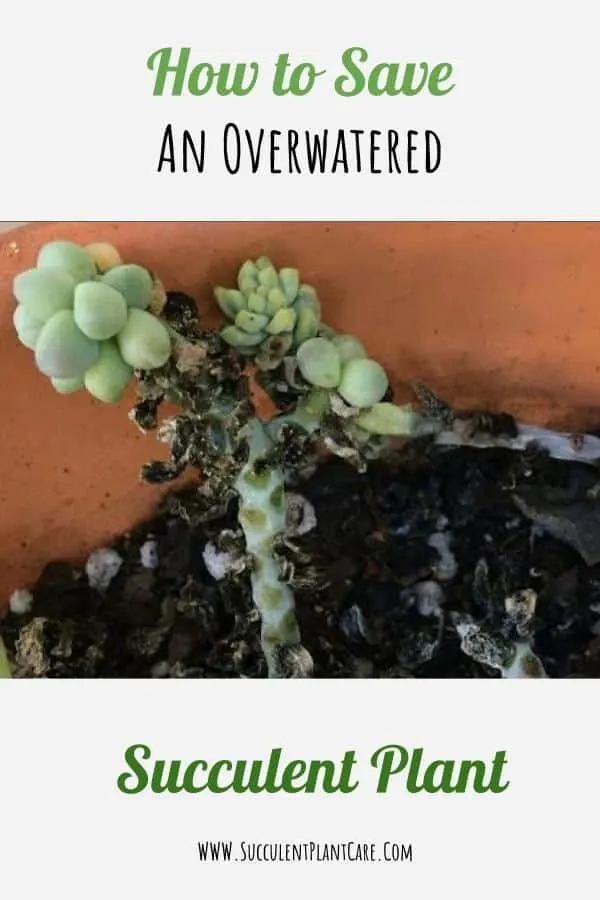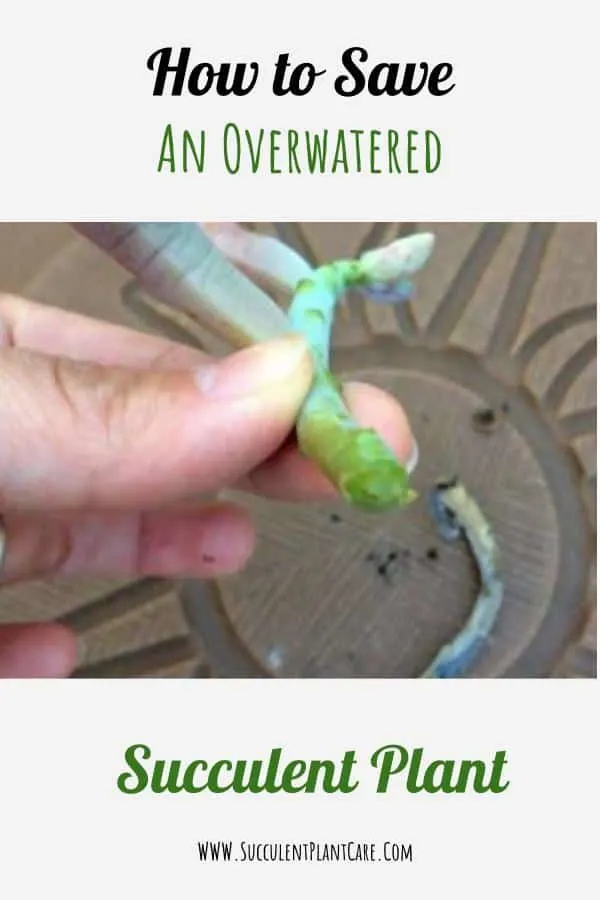Have you overwatered your succulent and now you’re wondering whether it could be saved or it’s too far gone?
Lucky for us, I have encountered a few overwatering mishaps with my succulents and can provide some helpful insights on what to do when you’ve overwatered your plants.
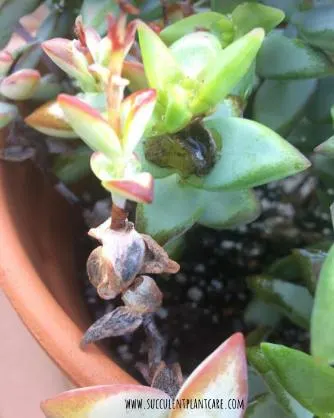
Can An Overwatered Succulent Be Saved?
Yes. Majority of the time an overwatered plant do bounce back with proper care and treatment. And even if the plant has succumbed to rot, some parts of it can still be saved. A leaf or a small stem can be saved and propagated to start a new plant.
How much of the plant you can save depends on the extent of the damage to the plant. An overwatered plant in the early stages will be easier to save than a plant that is already rotting from the root up.
What Does an Overwatered Succulent Look Like?
How do you know if your succulent is overwatered? Usually there are telltale signs that would tell you clearly whether a succulent is being overwatered or underwatered. An overwatered plant will have mushy leaves that feel soft and squishy.
The color of the leaves would appear lighter than a healthy plant, or turn translucent in color. A lot of times an overwatered succulent would drop leaves easily even when lightly touched. The bottom leaves are usually the ones affected first.
The plant will have an overall ‘sick’ appearance. When this happens, the plant is either sitting in the wrong soil that does not dry out fast enough, or it is being overwatered, or both.
If you have been watering your plant regularly or you’ve been sticking to a watering schedule regardless of how the plant looks and you see these signs I described above, your plants are being overwatered.
On the other hand, an underwatered succulent will have shriveled, wrinkled leaves that appear deflated. The leaves will feel flat and thin. The plant will have an overall wilted, dry appearance.
A healthy succulent plant should have plump, firm leaves that are not mushy or dehydrated.
To read more about this topic, click on my post where I describe in details how you can tell whether your succulent plant is being over or under watered “How To Tell If Your Succulent is Over or Under Watered”.
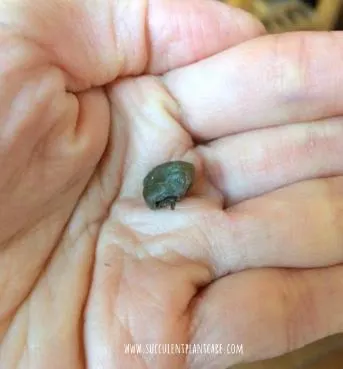
This is an overwatered leaf from a String of Pearls ‘Senecio Rowleyanus’ plant. An overwatered succulent can literally burst from overwatering if its water storage capacity has reached its max.
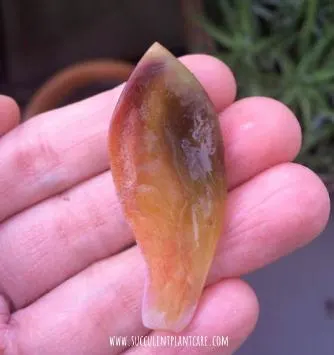
Mushy, overwatered succulent leaf that has turned translucent
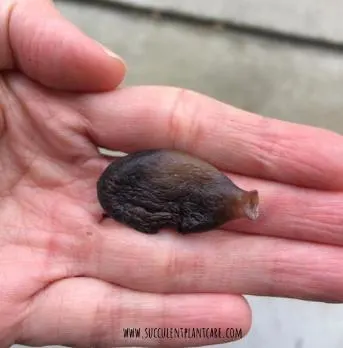
Overwatered succulent leaf that is starting to rot
What Does a Rotting Succulent Look Like?
A rotting succulent will have black leaves starting from the bottom. The stems would appear either black or brown, and mushy. These are signs that the plant is rotting from the roots up due to overwatering. If left on its own, the plant will continue to rot and you will be left with a plant that has dissolved and turned into a mushy mess.
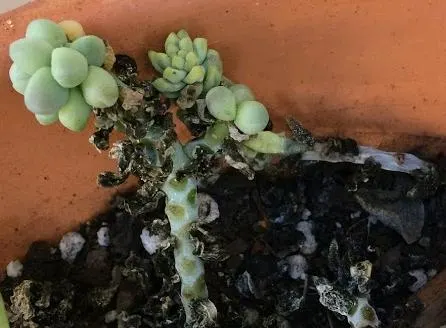
Rotting Sedum burrito (burro’s tail or donkey’s tail) plant with black leaves from overwatering
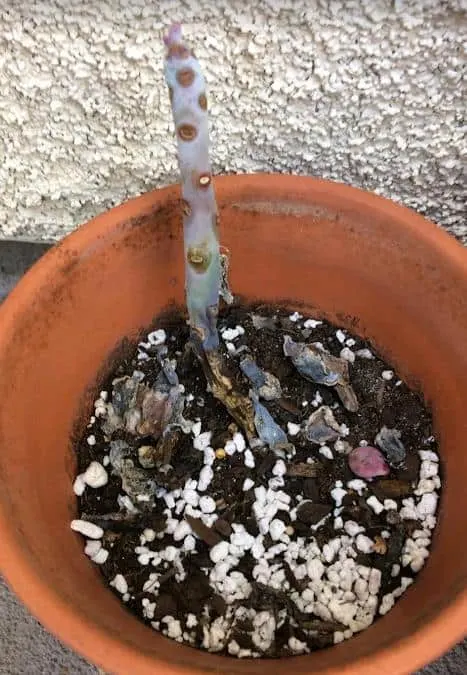
Rotting succulent from the root up due to overwatering

Rotting succulent stem from the root up due to overwatering.
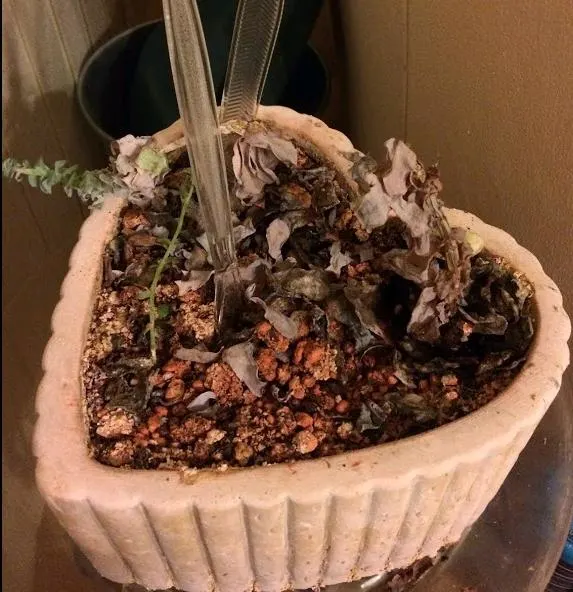
Unfortunately, this succulent planter cannot be saved. It has turned to mush from rot due to overwatering. (This was a mother’s day gift for my mom and it was loved to death by her)
So How Do We Save an Overwatered Succulent?
The earlier you intervene, the greater the chance that you can save your plant. The more the plant is overwatered, the more likely it is to succumb to rot. As you’ve seen above, there are instances where the plant is just too far gone and there is nothing you can do to save it.
If the plant is showing early signs of overwatering, such as mushy, soft and pale bottom leaves, the plant is literally drowning from too much water and it needs to dry out as soon as possible.
Steps on How To Save an Overwatered Succulent:
- It is best to remove the plant from wherever it is and remove all the wet soil from the roots.
- Let the plant dry out completely for at least three days to a week.
- Set the plant somewhere bright and dry, but away from direct sunlight to avoid burning the plant and the roots.
- Once dry, replant in a suitable well draining potting mix and do not water immediately. Wait for about a week before watering and refrain from overwatering again.
If you think your plant is already in the right potting mix but you were just heavy handed with watering your plants, you may get away with leaving the plant as is and not repotting it.
Just let the plant dry out completely before you water again.
Wait at least a week before you water again and before you do, check the top inch of the soil to feel for moisture. If it feels dry, you can water again. If it’s still wet, you need to repot your plant because the soil it’s in is not drying out fast enough.
Will The Leaves Grow Back?
Yes. If you lost a lot of leaves from overwatering, the plant will eventually recover as long as it is not rotting. When given a chance to dry out, you will soon notice new growth or tiny leaves along the stems.
You will also notice new growth from the sides, the top, or even the bottom of the plant. Once you notice new growth, it is usually a sign that your plant is off the danger zone and has fully recovered.
Steps on How to Save a Rotting Succulent From Overwatering:
- Inspect the plant for severity of the rot. If the rot is not severe, you will be able to find parts of the plant that you can save.
- Save any leaf that appears salvageable. Save as many leaves as you can to propagate. Leaf propagation can be tricky and you will need as much leaf as you can get to ensure that some of them make it. Make sure you get the entire leaf, including the base. A broken leaf will not make it.
- Place the leaves somewhere dry and out of direct sunlight and allow to dry for a few days.
- Once the leaves are dry, prepare a well draining potting mix and either lay the leaves flat on the soil or stick the ends in soil. (Optional: you can dip the leaves in rooting hormone. I tend to skip this part but some people like to use rooting hormones to increase the success rate and also speed up the process of propagation).
- Keep away from direct sunlight, mist every few days or when the soil feels dry. Wait for roots to grow and new plants to emerge.
Other than leaves, you can also save parts of the stem
- Inspect the stem and cut off any rotting areas, including the roots. Save any green or viable parts of the stem. You will know if it’s viable or not when you cut the stem. If the inside of the stem shows green tender parts, not brown or black, these may stand a chance and can be propagated to start a new plant.
- Place the saved stems somewhere dry and out of direct sunlight. Allow to dry for a few days to a week until all the cuts have calloused and sealed. (Optional: dip the stems in rooting hormone. I tend to skip this part but some people like to use rooting hormones to increase the success rate and also speed up the process of propagation).
- Once dry, prepare a well draining potting mix and stick the stems in soil.
- Mist every few days or when the soil feels dry. Keep away from direct sunlight until fully rooted to avoid sun damage.
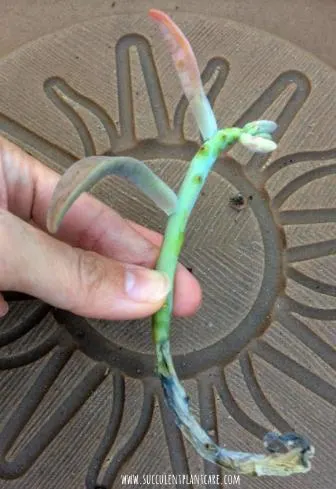
Rotting succulent stem from overwatering
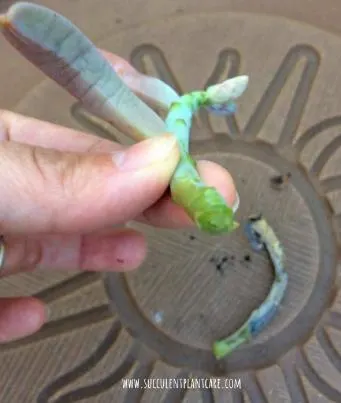
After cutting the rotten part off, you can see that the stem has plenty of green, viable parts left so it still can be saved. I let this stem dry for a few days and stuck it in soil to root and propagate.
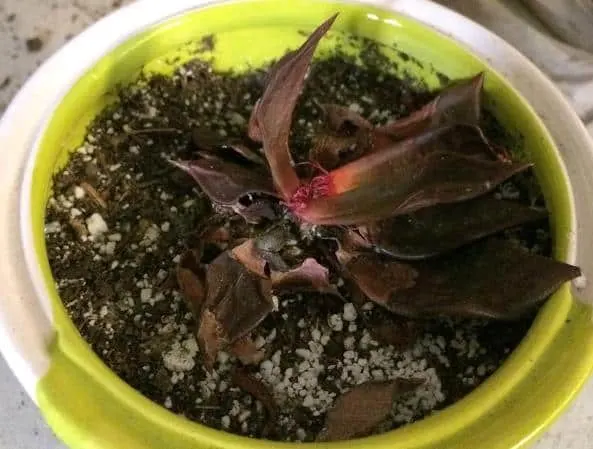
An echeveria that has rotted from overwatering. I saved some of the leaves to propagate.
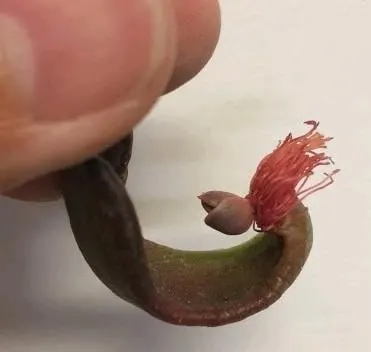
I was able to save this leaf from the echeveria to propagate in soil.
How To Avoid Overwatering Your Succulents
Watering tips
How you water your succulents that are outdoors will differ from how you water plants that are kept indoors. Outdoor plants usually receive more sunlight and tend to dry out faster. Indoor plants are more protected from the elements and therefore do not dry out as fast and do not need to be watered as much.
Before you stick to any watering schedule, it is best to get to know your plants. Rather than sticking to a watering schedule, it is better to figure out your plant’s individual watering needs.
Some succulents need more water than others. Aeoniums for instance, tend to like more water than other more tender plants such as Sedum burrito (burro’s tail or donkey’s tail), which rots easily with too much water.
You also need to take the climate you live in into consideration. If you live in a dry climate like where I am, the succulents dry out faster and will need to be watered more often. If you live in a humid climate, you do not need to water as much.
Watering also has a lot to do with the time of the year. In the summer, plants will need more water because of the heat and sun. During winter the plant does not need to be watered as much.
It is also important to pay attention to growing seasons. When the plant is actively growing, usually during spring and early summer, they need more water than when they are dormant, usually around winter time (with some exceptions depending on the succulent).
I water my plants every 7-10 days in the summer months and cut back on watering to about every 2 weeks in cooler months. I refrain from watering my plants altogether during winter season because this is when we get a lot of rain in my area.
Keep in mind that I keep most of my plants outdoors and we get plenty of bright sunlight here in California. If you live in a humid location, you may not need to water as much. And if your succulents are mostly indoors, adjust your watering accordingly.
Remember, it is easier to fix an underwatered succulent than an overwatered one so when in doubt, water less instead of more until you figure it out. To read more about watering succulents, I have written about this topic in detail here “How and When to Water Succulents”.
Tools such as moisture meters and hygrometers may help you gauge your plant’s watering needs by measuring the moisture in the air and the soil. Click on my resource page for my recommendations on these products.
Soil Requirements
The type of soil you use goes hand in hand with proper watering techniques. Even if you do not overwater your plant but it is sitting in the wrong potting mix, it can still suffer from overwatering. Succulents need a well draining potting mix. They do not like to sit in wet soil too long. They generally like a good drink of water, and then have some time to dry out.
I like to use cactus mix combined with perlite (1:1 solution). A sandy soil mixture is also recommended. You can achieve this by using cactus mix and coarse sand (1:1 solution). Or you can use a combination of the three materials mentioned in equal parts: cactus mix:perlite:coarse sand (1:1:1 solution).
To find some of these materials online, click on my resource page for soil recommendations. To read more about the right soil for succulents, click on my post “Best Soil and Fertilizer for Succulents”.
An overwatered succulent is not doomed–yet. Don’t lose hope. I have saved a few of my plants from the brink of death this way. Succulents are such resilient plants you will be surprised how much you can save even from a dying plant.
Check out my Resource Page for recommendations on where to purchase succulents online.
Pin this to save for yourself and share with others!
